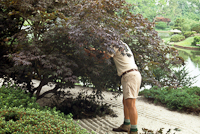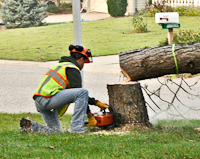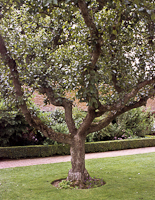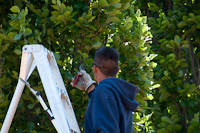 Some plants are sold as one-year whips
which are young
trees with a long stem and few or no branches. Most trees, however, are
sold as two-year, three-year or older specimens on which structural
branches have already begun to develop. Prune at planting only to remove
broken or damaged branches or roots, to remove branches that will not be
suitable to form the main framework, or to shape the plant to a somewhat
symmetrical form. Do not prune back the central leader of the tree
unless you want no leader as with certain small flowering trees or plant
you wish to be multiple stemmed.
Some plants are sold as one-year whips
which are young
trees with a long stem and few or no branches. Most trees, however, are
sold as two-year, three-year or older specimens on which structural
branches have already begun to develop. Prune at planting only to remove
broken or damaged branches or roots, to remove branches that will not be
suitable to form the main framework, or to shape the plant to a somewhat
symmetrical form. Do not prune back the central leader of the tree
unless you want no leader as with certain small flowering trees or plant
you wish to be multiple stemmed.
Early pruning to direct the growth of young trees is
very important if mature trees are to function as expected in the
landscape.
 The growth habit of a plant and its landscape use
determine how and to what extent the tree must be pruned. Trees with a
central leader and a conical shape, such as conifers and some deciduous
species, need little or no pruning. Trees with irregular growth habits,
poor branch structure or vigorous laterals, such as
sugar maple, may
need considerable pruning.
The growth habit of a plant and its landscape use
determine how and to what extent the tree must be pruned. Trees with a
central leader and a conical shape, such as conifers and some deciduous
species, need little or no pruning. Trees with irregular growth habits,
poor branch structure or vigorous laterals, such as
sugar maple, may
need considerable pruning.
Prune a young tree only enough to effectively direct
its growth and to correct any structural weakness.
Branches selected for permanent scaffolds must have
wide angles of attachment with the trunk for greatest strength. The
position of a limb on a trunk remains the same throughout the life of
the tree. How high above the ground the first permanent branch should be
depends on the tree's use. The lowest branch can be a few inches from
the ground in trees used for screening or windbreaks, or 6 to 12 feet
above the ground in trees over a street or a patio.
 Vertical branch spacing is important in many species
for future dominance, structural strength and appearance of the tree. On
mature trees, closely spaced scaffolds may break up in storms more
easily than more widely spaced ones. Closely spaced scaffolds will have
fewer laterals, resulting in long, thin branches with little structural
strength. Major scaffold branches should be spaced at least 8 inches and
preferably 10 to 24 inches apart vertically.
Vertical branch spacing is important in many species
for future dominance, structural strength and appearance of the tree. On
mature trees, closely spaced scaffolds may break up in storms more
easily than more widely spaced ones. Closely spaced scaffolds will have
fewer laterals, resulting in long, thin branches with little structural
strength. Major scaffold branches should be spaced at least 8 inches and
preferably 10 to 24 inches apart vertically.
Radial branch distribution should allow five to seven
main scaffolds to fill the circle of space around the trunk. With radial
spacing, branches radiate from the trunk like spokes on a wheel. Because
no one limb is directly over another they do not compete for light.
Direct plant growth by pruning during the growing
season as well as when the tree is dormant. During the growing season,
pruning is usually confined to temporary shoots and branches that will
not become permanent branches. Heading back the growing point or
completely removing a shoot will reduce its competition with the leader
or shoots selected for scaffold limbs. Remove or prune shoots that are
too low, too close or too vigorous in relation to the leader and shoots
selected to become the scaffold branches.
 During the growing season, heading back the tips of
vigorous growing, temporary branches may be necessary to keep them in
bounds and reduce competition with the leader and permanent branches.
During the growing season, heading back the tips of
vigorous growing, temporary branches may be necessary to keep them in
bounds and reduce competition with the leader and permanent branches.
A tree at planting may not be tall enough for the
selection of any permanent lateral branches. If laterals are present
below the height where the lowest permanent branch is wanted, they
should be handled as temporary laterals. After two or three years, when
the trunks of small trees are 2 or more inches in caliper, you can begin
to reduce the number of temporary branches. Over the next two or three
years remove the largest temporary branches at each pruning to minimize
the size of the pruning wounds.



